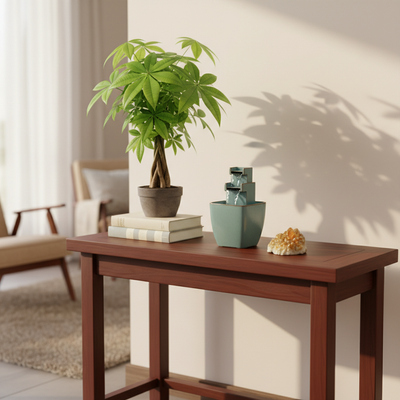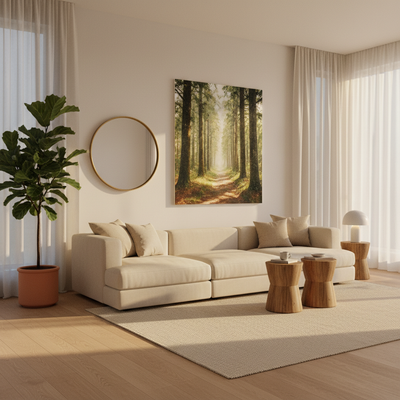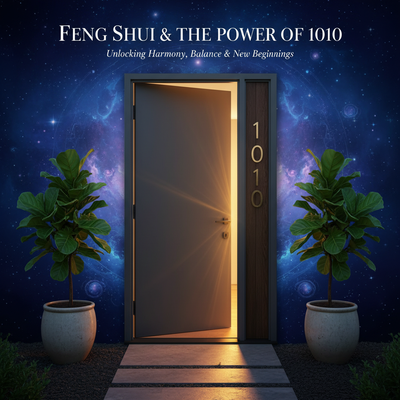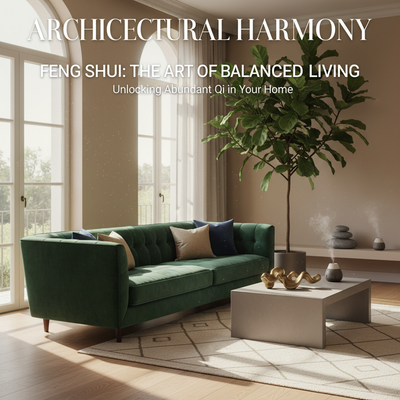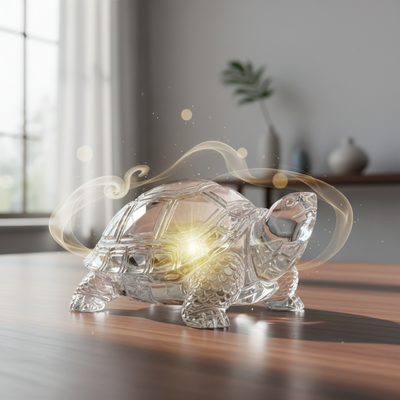Your bedroom should be the most peaceful room in your home. It's more than just a place to sleep; it's your personal safe space where you start and end each day, a place for closeness, and a spot for rest and healing. Yet, for many people, it becomes a source of stress—a messy, uninspiring room that makes it hard to rest. This is where the ancient practice of feng shui can make a huge difference. This guide will give you clear, step-by-step instructions on using feng shui decor to improve your bedroom's energy, or Qi. By making smart choices about where you place things, what colors you use, and what materials you choose, you can create a peaceful environment that helps you sleep better, feel healthier, and have stronger relationships. It's about designing a space that actively helps your well-being.
Mastering the Command Position

The most important rule in bedroom feng shui is placing your bed in the command position. This is the foundation that all other changes are built on. Getting this position right directly affects how safe, secure, and in control you feel, which helps you relax completely.
What is Command Position?
The command position is the spot in a room that is farthest from the door and not in a straight line with it, but from which you can still see the entrance. Think of a boss's office; their desk is almost always positioned so they have a clear view of who is coming in, giving them a sense of power and awareness. In the bedroom, this creates a feeling of safety. When your nervous system feels secure because it can see any potential approach, it can turn off from high alert and enter a state of deep rest.
Golden Rules of Bed Placement
To get the best possible energy flow for sleep and rest, follow these basic do's and don'ts for your bed placement.
- DO: Place the bed diagonally across from the door. This is the main rule of the command position, making sure you see the door without being directly in its path.
- DO: Make sure you have a solid headboard. A strong, sturdy headboard represents support and stability in your life. It gives you a sense of being backed and protected while you sleep. Wood or upholstered headboards are excellent choices.
- DO: Place the headboard against a solid wall. This strengthens the feeling of support. A solid wall behind you is like having a mountain at your back, giving you a stable foundation for your rest and your life.
- DON'T: Place the bed directly in line with the door. Known as the "coffin position," this placement exposes you to Qi that rushes too forcefully into the room, disrupting your personal energy field and leading to restless sleep.
- DON'T: Place the bed under a window. A window does not provide the same solid support as a wall, which can lead to a feeling of being unsafe and energy drain. It can also disrupt sleep due to light, drafts, and noise.
- DON'T: Place the bed under a sloped ceiling or heavy beam. These building features create a heavy, oppressive energy (Sha Qi) that can weigh down on you while you sleep, potentially leading to headaches or a feeling of being stuck.
- DON'T: Have one side against a wall. If you are in a relationship, pushing one side of the bed against a wall symbolically blocks one partner's energy and access. Make sure there is space on both sides to promote equality and balanced energy flow.
Understanding the Bagua Map
To move beyond basic rules and truly customize your space, you need the feng shui Bagua map. The Bagua is a foundational tool, an energy map of your space that matches nine key areas of life. Understanding this tool gives you the power to make targeted decor choices that improve specific goals, whether it's improving your relationship, boosting your career, or nurturing your health.
How to Read Your Bagua
Reading the Bagua is simpler than it sounds. Imagine a three-by-three grid. You mentally place this grid onto your bedroom's floor plan. The key is to align the bottom row of the grid with the wall that contains your bedroom's main door. The door itself will fall into one of the three bottom squares: Knowledge, Career, or Helpful People. Once aligned, each section of your room now matches a specific life area. This map, taken from the ancient Chinese text, the I Ching, provides a blueprint for intentional decoration.
The 9 Life Areas
Once you've aligned the map with your door wall, you can identify each of the nine life areas within your bedroom.
-
Top Row (Farthest from the door):
- Far Left: Wealth & Prosperity
- Top Center: Fame & Reputation
- Far Right: Love & Marriage
-
Middle Row:
- Middle Left: Family & Health
- Center: Tai Chi (Overall Well-being)
- Middle Right: Children & Creativity
-
Bottom Row (Wall with the door):
- Bottom Left: Knowledge & Self-Cultivation
- Bottom Center: Career & Life Path
- Bottom Right: Helpful People & Travel
Now, when you want to improve a specific area, such as romance, you know to focus your decor efforts on the far-right corner of your room.
Choosing Your Color Palette
Color is a powerful tool in feng shui as it directly influences your mood and the room's energy. Rather than giving you a rigid set of "good" or "bad" colors, the feng shui approach is to choose a palette based on the energy you wish to create in your sanctuary.
For Rest and Healing
To create the most restful and healing environment, turn to earth tones and skin-tone neutrals. Shades like soft beige, warm taupe, gentle cream, and rich cocoa are ideal. These colors are connected to the Earth element, which promotes feelings of stability, nourishment, and grounding. They create a calming, cocoon-like atmosphere that soothes the nervous system and encourages deep, restorative sleep. These colors are universally beneficial for a bedroom as they create a neutral, supportive backdrop for your life.
To Foster Love and Romance
If your intention is to foster connection and passion, incorporate colors from the Fire element. Soft pink is considered the universal color of love, promoting gentleness and affection. For more passion, use red as a strategic accent. A room painted entirely in red would be far too stimulating for rest, but a single red cushion, a piece of art with red highlights, or a pair of small red objects in your Love & Marriage corner can effectively activate romantic energy. Soft whites also work well, symbolizing purity and openness.
For Calm and Renewal
Blues and greens are wonderful for creating a sense of calm and renewal, but their use in the bedroom requires a gentle touch. These colors connect to the Wood element (growth) and Water element (flow). To keep the energy peaceful, choose soft, muted versions. A pale sage green can bring feelings of new growth and health, while a dusty, muted blue can bring a tranquil, spa-like quality to the space. Avoid bright, electric blues or greens, which are too active for a restful environment.
Balancing the Five Elements
To achieve a truly harmonious space, an expert feng shui practitioner looks beyond individual rules to the complete balance of the Five Elements, or Wu Xing. These elements—Wood, Fire, Earth, Metal, and Water—are the fundamental building blocks of Qi. The goal is not to have all five in equal measure, but to create a balanced cycle where the elements support each other, creating a dynamic and nurturing environment. You can achieve this by thoughtfully incorporating materials, shapes, and colors into your decor.
Incorporating Each Element
Use the following table as a guide to layer the elements into your bedroom decor. A well-balanced room might be mostly Earth for grounding, with accents of Wood for vitality and Metal for clarity.
| Element | Energy | Decor Shapes | Decor Colors | Specific Decor Ideas |
|---|---|---|---|---|
| Wood | Growth, Vitality | Rectangular, Tall | Greens, Blues | Healthy plants with soft leaves, linen curtains, a tall wooden dresser, striped patterns. |
| Fire | Passion, Energy | Triangular, Pointed | Reds, Oranges, Pinks | A single red throw pillow, candle (used sparingly), art with sunrise imagery, star shapes. |
| Earth | Stability, Grounding | Square, Flat | Beiges, Yellows, Browns | Ceramic planters, a soft wool rug, landscape photos of fields, low and flat furniture. |
| Metal | Clarity, Precision | Round, Spherical | Whites, Grays, Metallics | A round metal-framed mirror, brass or chrome drawer pulls, a simple white vase, polka dots. |

| Water | Flow, Wisdom | Wavy, Flowing | Blacks, Dark Blues | A piece of art with a flowing river, a mirror (which represents water), asymmetrical shapes. |
Curating Your Sanctuary
Once you understand the core principles, the next step is to curate your space by intentionally adding supportive items and removing disruptive ones. This process of decluttering and decorating is about making conscious choices that align with your goal of creating a restful sanctuary.
Feng Shui Decor to Add
- Pairs of Items: To symbolize and attract a harmonious partnership, incorporate items in pairs. Two matching nightstands and two matching lamps are essential. This creates a sense of balance and equality, even if you are single and wish to attract a partner.
- Soft, Layered Lighting: Avoid harsh, overhead "big light" fixtures. Instead, use a combination of soft light sources. Dimmable lamps on your nightstands, a gentle floor lamp in a corner, or even wall sconces create a warm, inviting, and adjustable ambiance.
- Natural Materials: Connect your space to the natural world by using materials like organic cotton or linen for bedding, a wool rug underfoot, and wooden furniture. These materials have a calming, grounding energy.
- Inspiring Artwork: The art in your bedroom should reflect the feelings you want to cultivate. Choose images that bring peace, joy, and connection. Peaceful landscapes, beautiful abstracts in calming colors, or tasteful images representing loving partnership are all excellent choices. Avoid sad or lonely imagery.
- A Plush Rug: A soft rug underfoot helps to ground the energy of the room and absorb sound. It adds a layer of comfort and defines the rest area, making the bed feel like a special, contained island of tranquility.
Decor and Items to Remove
Just as important as what you add is what you remove. Certain items carry an active, stressful, or disruptive energy that is fundamentally at odds with the purpose of a bedroom.
| Item to Remove/Avoid | Why It Disrupts Feng Shui | What to Do Instead |
|---|---|---|
| Electronics (TV, Computer) | Emits active "yang" energy and electromagnetic frequencies (EMFs) that disrupt sleep, communication, and intimacy. The bedroom is for rest, not work or entertainment. | Move them to another room. If you absolutely must have a TV, conceal it inside a cabinet and cover all devices with a cloth at night. |
| Mirrors Facing the Bed | Mirrors are energy activators. A mirror reflecting the bed is believed to bounce too much energy around, disrupting sleep. It is also thought to invite the energy of a third party into a relationship. | Relocate the mirror to a wall that doesn't reflect the bed. The best placement is often inside a closet door, where it is functional but hidden. |
| Water Features (Fountains) | While wonderful in other parts of the home, the active, flowing energy of a water feature can introduce the energy of worry or even potential financial loss when placed in the bedroom. | Move fountains to your living room or office, especially in the Wealth area of your home's Bagua. |
| Clutter (Especially Under the Bed) | Clutter blocks the flow of Qi, creating stagnant energy that can lead to feeling stuck in life. Clutter under the bed is particularly disruptive, as you are sleeping on top of this stagnant energy all night. | Clear it out completely. If you must use the space for storage, limit it to soft, sleep-related items like clean bedding, pillows, and blankets. |
| Exercise Equipment | Treadmills, stationary bikes, and weights represent work, exertion, and active energy. Their presence in the bedroom sends a conflicting message to your mind and body, making it difficult to unwind. | Designate a different area of your home, even a small corner of the living room, for workouts. The bedroom is for rest only. |
| Dead/Dying Plants or Spiky Plants | Dead or dying plants represent stagnant or decaying energy (Si Qi), which you do not want in your sanctuary. Spiky plants like cacti project a sharp, defensive energy (Sha Qi). | Replace them immediately with healthy, vibrant plants that have soft, rounded leaves, such as a snake plant or pothos, which also purify the air. |
Case Study: A Client's Restless Bedroom
To illustrate the real-world impact of these principles, we want to share a story from our work. It shows how targeted changes, guided by feng shui, can produce profound results.
The Problem: Stress and Sleeplessness
A client, Sarah, came to us at THE QI FLOW feeling constantly drained. Her bedroom, meant to be her retreat, felt chaotic and stressful. She reported difficulty falling asleep, waking up frequently during the night, and a persistent feeling of being "on edge" even when trying to relax. The energy in her most personal space was working against her.
Our Feng Shui Analysis
Our initial assessment of her bedroom revealed several key energy blocks that were contributing to her poor sleep.
* First, her bed was pushed directly under a large window. This violated the principle of having a solid wall for support, leaving her feeling subconsciously vulnerable and unsupported.
* Second, a large, uncovered mirror on her dresser directly faced the bed, bouncing active energy around the room all night and disrupting her rest.
* Finally, a corner of the room had become a makeshift home office, complete with a desk, laptop, and piles of paperwork. This introduced the active, stressful energy of work directly into her sleep environment.
The Solution: A Practical Transformation
We worked with Sarah to implement a few simple, high-impact changes based on foundational feng shui principles.
* Our first and most crucial move was to rearrange the room to place her bed against the solid wall, putting her in the command position where she could see the door. This immediately created a sense of security.
* Next, we had her move the desk and all work-related items into a small nook in her living room, reclaiming the bedroom purely for rest. The mirror was relocated to the inside of her closet door.
* To complete the transformation, we suggested a new color palette of soft, earthy beiges to enhance the calming energy. We also had her add a pair of matching bedside lamps and nightstands to create balance and symmetry.
The Result: A True Sanctuary
Within weeks, Sarah reported a dramatic shift. She was falling asleep more easily and sleeping through the night for the first time in months. She described her bedroom as her "favorite room in the house," a place where she could finally unwind, feel safe, and truly recharge. This case highlights how bedroom decor feng shui is not just about aesthetics; it's a powerful practice for improving your overall well-being.
Advanced Finishing Touches
Once you've mastered the fundamentals of placement, color, and decluttering, you can add these advanced layers to create a truly high-vibration space.
Quick Harmony Tips
- Activate your Love Corner: The far-right corner from your bedroom door is your Love & Marriage area. To enhance this, place items that symbolize love to you. A pair of rose quartz crystals, two pink candles, or a beautiful photo of you and your partner are all powerful activators.
- Use Scents to Shift Energy: Scent is a potent way to influence a room's Qi. Use a high-quality essential oil diffuser with calming scents like lavender, chamomile, or sandalwood before bed. Avoid artificial air fresheners, which can introduce chemicals and jarring energy.
- Clear Energy Regularly: Energy can become stagnant over time. Open your windows as often as possible to let in fresh air and new Qi. Periodically, you can perform a space-clearing ritual, such as smudging with sage or palo santo, to reset the room's energy and clear away any lingering negativity.
- Symmetry is Your Friend: Beyond matching nightstands, look for other opportunities to create symmetry. A pair of matching pillows on the bed or two identical art prints on a wall creates a visual and energetic feeling of stability, calm, and equality, which is especially important for a couple's space.
Your Bedroom, Your Journey
Transforming your bedroom with feng shui is a journey, not a destination. It's about creating a conscious, supportive relationship with your most personal space. Don't feel you need to do everything at once. Start with the single most impactful change: moving your bed into the command position. Then, clear the clutter from under your bed. Make one or two changes and notice how you feel. As you slowly layer in these principles, you will create a bedroom that not only looks beautiful but also feels like a true sanctuary—a space that nurtures your sleep, your relationships, and your soul. You have the power to design a room that supports the life you want to live.
